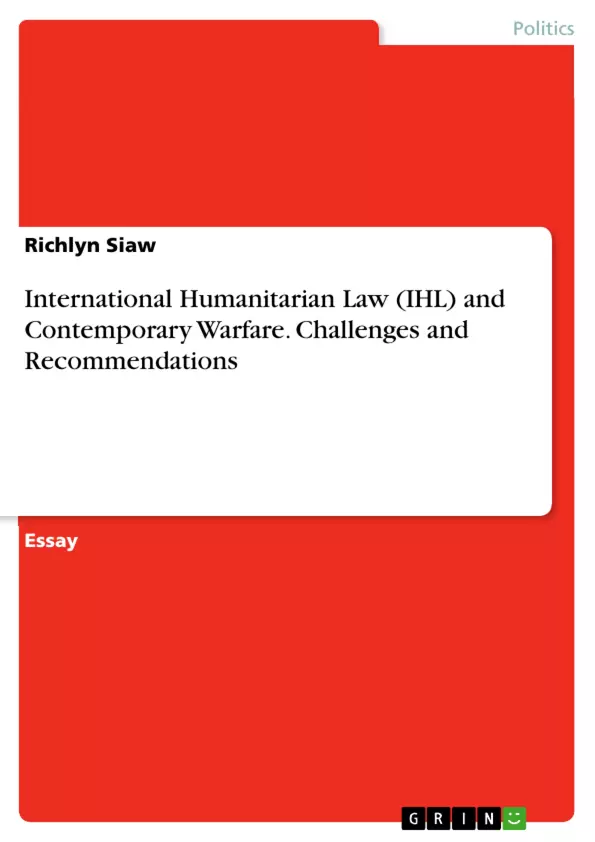This paper offers recommendations to amend International Humanitarian Law (IHL) to meet the needs of contemporary warfare. In an attempt to rehash emerging and existing challenges of the Law of Armed Conflict, the author contextualizes the factors underpinning the prevalent disregard for IHL.
Inhaltsverzeichnis (Table of Contents)
- The History of Warfare
- Evolution of IHL
- Nature of Contemporary Warfare
- Highlights of Relevant Aspects of IHL
- Challenges and Highlights of IHL that Require Revision
Zielsetzung und Themenschwerpunkte (Objectives and Key Themes)
This text explores the relevance and challenges of International Humanitarian Law (IHL) in contemporary warfare, arguing that the changing nature of conflict necessitates a reassessment of its applicability and effectiveness. It aims to highlight key principles and provisions of IHL while addressing emerging concerns regarding its implementation in a rapidly evolving battlefield.
- The historical evolution of warfare and the development of IHL
- The nature of contemporary warfare, including the role of information warfare and state-of-the-art weapons
- Key principles and provisions of IHL, such as the protection of civilians, vulnerable groups, and civilian objects
- Challenges to the effective implementation of IHL, including the difficulty in categorizing conflict, the principle of "equality of belligerents," and the changing nature of warfare
- The need for periodic review and adaptation of IHL to address contemporary challenges.
Zusammenfassung der Kapitel (Chapter Summaries)
- The History of Warfare: This section traces the evolution of warfare from its primitive origins to the modern era, highlighting the shifting motivations and methods of conflict. It underscores the enduring pursuit of political and economic gains in warfare and examines the increasing brutality of war in the 20th century due to technological advancements.
- Evolution of IHL: This chapter explores the development of International Humanitarian Law (IHL), tracing its origins to the 'law of war' and the 'law of armed conflict'. It examines the key milestones in IHL's evolution, including the 1864 Geneva Convention and the subsequent development of international treaties designed to protect civilians and mitigate the effects of war.
- Nature of Contemporary Warfare: This section explores the transformation of contemporary warfare, noting the shift from traditional military engagements to the use of advanced technology, information warfare, and ideological conflicts. It highlights the growing importance of understanding and adapting to these new realities in the context of IHL.
- Highlights of Relevant Aspects of IHL: This chapter focuses on specific provisions of IHL, including Article 2(4), which emphasizes the protection of state sovereignty, and Article 3 of the Conventions, which applies to both international and non-international armed conflicts. It also examines the role of Additional Protocols I and II in strengthening the protection of civilians.
- Challenges and Highlights of IHL that Require Revision: This section delves into the challenges facing the implementation and effectiveness of IHL in contemporary warfare. It explores concerns regarding the categorization of conflicts, the principle of "equality of belligerents," and the difficulties in applying IHL in complex, multinational, and non-international conflicts.
Schlüsselwörter (Keywords)
International Humanitarian Law (IHL), contemporary warfare, information warfare, state sovereignty, protection of civilians, non-international armed conflict, Geneva Conventions, Additional Protocols, equality of belligerents, challenges to implementation, adaptability.
- Quote paper
- Richlyn Siaw (Author), 2022, International Humanitarian Law (IHL) and Contemporary Warfare. Challenges and Recommendations, Munich, GRIN Verlag, https://www.hausarbeiten.de/document/1263974


